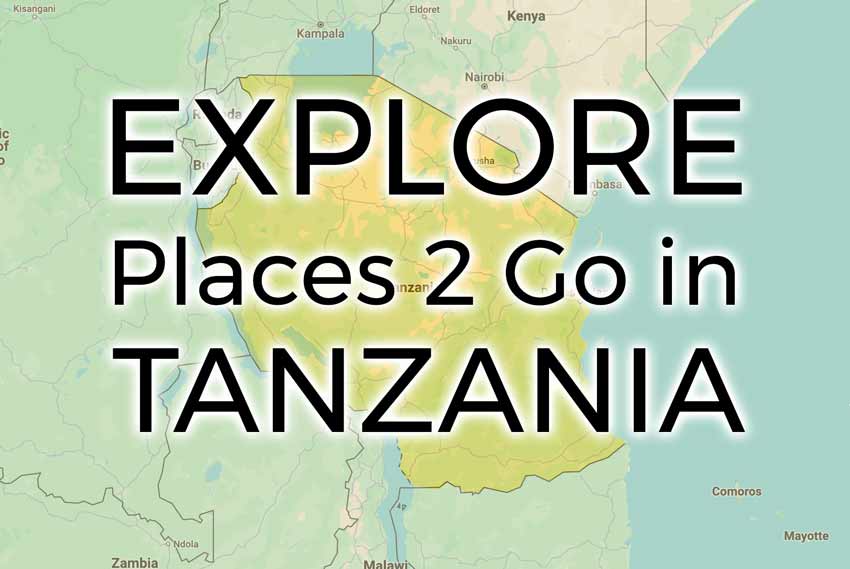Description: Lake Manyara has a considerably different landscape from any of the other parks. Picture lush woodlands and the beaches of this Rift Valley lake where giraffe, elephants and wildebeest enjoy an endless supply of water. You will often see these enormous animals in the water, sitting, sipping or just cooling off. Due to this unique habitat, there are hundreds of bird species able to live in the forests and the ultimate site-seeing prize of this area is the tree-climbing lion.
Although this park is relatively small, it is still quite impressive. Most of the park is covered in forest or thick bush, sometimes making it difficult to spot wildlife. On shorter itineraries, we usually recommend omitting Lake Manyara, but it still gets visited frequently because of its convenient location between Tarangire and Ngorongoro Crater. This is one of the two parks where you can do night game drives within the park boundaries.
Location: Approximately 2.5 hours from Arusha on the road en route to the Ngorongoro Crater. Accommodations can be utilized in Mto Wa Mbu near to Manyara or up the hill in Karatu which is about 30 minutes beyond Manyara.
Things 2 Do: Game Drives, Mountain Biking, Forest Hike, Night Game Drive, Nature Walk, and Village Visit
Time: Can be visited in one day, but biking or hiking require a separate day. Might be excluded on a short itinerary or when your trip is deep in dry season.
Animals: Elephants, Wildebeest, Buffalo, Hippo, Impala, Bushbuck, Waterbuck, Klipspringers, Zebra, Giraffe, Mongoose, Warthog, Leopards and the famous tree-climbing Lions, Blue Monkeys, Vervet Monkeys, Baboons, and over 380 bird-species including impressive flocks of Flamingos feeding on the lake’s algae.
Accommodations
$
A2T Camping (public campsites)
Bougainvillea Safari Lodge (Karatu)
Country Lodge (Karatu)
Eileen’s Trees Inn (Karatu)
Kudu Lodge (Karatu)
$$
Bashay Rift Valley Lodge
Kirurumu Manyara Lodge
Lake Manyara Wildlife Lodge
Ngorongoro Farmhouse (Karatu)
Ngorogoro Farm House Valley Lodge (Karatu)
Tloma Lodge (Karatu)
$$$
Escarpment Luxury Lodge
Kitela Lodge (Karatu)
Lake Manyara Serena Lodge
Neptune Ngorongoro Luxury Lodge (Karatu)
Plantation Lodge (Karatu)
The Retreat at Ngorongoro (Karatu)
$$$$
Chem Chem Lodge
Gibb’s Farm (Karatu)
Lake Manyara Tree Lodge
Manyara Ranch Conservancy
The Manor at Ngorongoro (Karatu)
Visit the Hadzabe at Lake Eyasi
Lake Eyasi Accomodations
$$
Tindiga Tented Camp$$$
Lake Eyasi Safari Lodge
Kisima Ngeda Tented Camp
Lake Manyara National Park Safari – A Gateway to Untamed Africa
What makes a safari to Lake Manyara National Park different from anywhere else in Tanzania? This question excites every traveler who is drawn to Africa’s extraordinary wildlife. Nestled in the Great Rift Valley, Lake Manyara offers a unique safari experience that blends lush forests, shimmering water, diverse wildlife, and breathtaking birdlife. On an Africa safari Lake Manyara journey, you witness a rare blend of ecosystems that attract animals and travelers alike, all within a park that, while relatively compact, packs an unforgettable punch.
The Distinct Charm of Lake Manyara National Park
Unlike the vast plains of the Serengeti or the highlands of the Ngorongoro Crater, Lake Manyara National Park is shaped by the Rift Valley escarpment, a dramatic backdrop that stretches across its length. Here, giraffes browse beneath mahogany and fig trees, elephants emerge from dense woodlands, and wildebeest graze on the grassy lakeshores. The lake itself provides a lifeline, attracting hippos, buffalo, and flocks of flamingos that feed on its algae.
The highlight for many visitors is the chance to see the legendary tree-climbing lions. Few parks in Africa host these big cats that spend daylight hours draped across branches, resting above the ground. This unique behavior has made Lake Manyara National Park safari itineraries especially appealing for wildlife enthusiasts and photographers.
A Small Park with a Big Personality
Though smaller in size compared to Tanzania’s other famous reserves, Lake Manyara packs in an incredible diversity of habitats. From dense forests and acacia woodlands to marshy swamps and wide-open grasslands, each zone supports different species. Over 380 bird species thrive here, making it a paradise for birdwatchers. Visitors can often spot flamingos, pelicans, storks, and raptors circling above the cliffs.
Because of its dense vegetation, spotting wildlife can sometimes be more challenging than in open savannahs. Yet, this challenge adds to the excitement, as every turn of the road reveals a fresh surprise. For travelers on shorter itineraries, Lake Manyara is sometimes overlooked, but its proximity to Tarangire National Park and Ngorongoro Crater ensures it remains a key stop for many safaris.
Night Game Drives – An Unforgettable Adventure
One of the unique aspects of a Lake Manyara safari is the chance to embark on a night game drive. Only a few national parks in Tanzania permit this experience, making it a rare opportunity. As the sun sets and darkness settles, nocturnal animals like civets, genets, porcupines, and even leopards emerge. With the help of spotlights, guides reveal a completely different side of the park that daytime visitors never see.
Location and Accessibility
Lake Manyara National Park is conveniently located about 2.5 hours by road from Arusha, the starting point for many safari adventures. Its strategic position en route to Ngorongoro Crater makes it an easy inclusion in most northern circuit itineraries. Accommodations are available in the nearby town of Mto Wa Mbu, just outside the park gates, or in Karatu, a scenic town located on the escarpment roughly 30 minutes away.
This accessibility allows visitors to enjoy the park even on a single-day trip. However, for those who wish to explore further through biking trails, forest hikes, or cultural visits, an overnight stay is highly recommended.
Activities on a Lake Manyara Safari
Beyond traditional game drives, Lake Manyara offers a wide range of activities to keep visitors engaged:
- Game Drives: Morning and afternoon drives reveal the park’s diverse wildlife.
- Mountain Biking: Ride along the lake’s edge or through Mto Wa Mbu village for an active way to explore.
- Forest Hikes: Guided walks through dense forests bring you closer to waterfalls and smaller creatures often missed from vehicles.
- Night Game Drives: A rare experience to see the park after dark.
- Nature Walks: Short guided walks give insight into flora, insects, and birdlife.
- Village Visits: Cultural tours of Mto Wa Mbu showcase local farming, banana plantations, and traditional crafts.
These varied activities make an Africa safari Lake Manyara more than just wildlife viewing – it becomes a holistic experience combining nature, adventure, and culture.
Wildlife Encounters in Lake Manyara
The park is renowned for its elephants, often seen bathing and feeding along the lake’s edge. Large herds of wildebeest and buffalo roam the plains, while impalas, bushbucks, and waterbucks are frequently sighted in the woodlands. Klipspringers, a small antelope species, can sometimes be spotted navigating rocky slopes near the escarpment.
Predators include leopards, hyenas, and of course, the famous tree-climbing lions. Primate life is equally rich, with troops of baboons often stopping traffic on safari roads. Blue monkeys and vervet monkeys add to the variety.
Birdwatchers find paradise here, with hornbills, eagles, flamingos, and more filling the skies. The sheer number of species in such a compact area makes Lake Manyara one of Tanzania’s most rewarding birding destinations.
When to Visit Lake Manyara
Lake Manyara can be visited year-round, though the experience changes with the seasons. During the wet months, the park bursts with greenery and birdlife. The dry season, while making wildlife easier to spot as animals congregate around water sources, can sometimes reduce flamingo numbers due to lower lake levels.
Many travelers include Lake Manyara in shorter itineraries or as a stop between larger parks. For those who enjoy hiking or biking, it’s best to allow an extra day.
Accommodations Near Lake Manyara
Lake Manyara offers accommodation options to suit all budgets. From public campsites to luxury lodges, travelers can choose stays that match their safari style. Options include charming lodges in Karatu, tented camps close to the park, and exclusive lodges with views of the Rift Valley escarpment.
- Budget ($): A2T Camping, Bougainvillea Safari Lodge, Country Lodge, Eileen’s Trees Inn, Kudu Lodge
- Mid-Range ($$): Bashay Rift Valley Lodge, Kirurumu Manyara Lodge, Lake Manyara Wildlife Lodge, Ngorongoro Farmhouse, Tloma Lodge
- Luxury ($$$): Escarpment Luxury Lodge, Kitela Lodge, Lake Manyara Serena Lodge, Neptune Ngorongoro Luxury Lodge, Plantation Lodge
- Premium ($$$$): Chem Chem Lodge, Gibb’s Farm, Lake Manyara Tree Lodge, Manyara Ranch Conservancy, The Manor at Ngorongoro
For those extending their journey to Lake Eyasi, cultural visits to the Hadzabe people can be combined with stays at Tindiga Tented Camp or Kisima Ngeda Tented Camp.
Why Choose Access 2 Tanzania?
With years of experience organizing personalized safaris, Access 2 Tanzania ensures every detail of your Lake Manyara National Park safari is carefully planned. From expert guides to handpicked accommodations, each journey is crafted to balance adventure with comfort. Whether you wish to focus on wildlife, culture, or photography, our tailored itineraries maximize your time and create unforgettable experiences.
Frequently Asked Questions (FAQs)
Q1: How long should I spend on a Lake Manyara safari?
A full day is enough to enjoy game drives, but if you wish to hike, bike, or include cultural tours, staying overnight is ideal. Many travelers combine it with Tarangire or Ngorongoro for a richer itinerary.
Q2: Is Lake Manyara suitable for birdwatching safaris?
Yes, it is one of Tanzania’s best birding locations. Over 380 species have been recorded, including large flocks of flamingos, raptors, and migratory species, making it perfect for birdwatchers year-round.
Q3: What makes Lake Manyara’s lions special?
Lake Manyara is one of the few places where lions are known to climb trees. This unusual behavior allows visitors a rare chance to see big cats lounging on branches in daylight.
Q4: Can I do a night game drive in Lake Manyara?
Yes, Lake Manyara is one of the two parks in northern Tanzania where night game drives are permitted. These drives reveal nocturnal animals not visible during the day.
Q5: What animals can I expect to see at Lake Manyara?
Visitors can spot elephants, wildebeest, buffalo, hippos, zebras, giraffes, baboons, monkeys, and predators like leopards. Birdlife is equally diverse, with flamingos and storks being major highlights.
Q6: When is the best time to visit Lake Manyara?
Lake Manyara can be visited throughout the year. The wet season brings lush vegetation and abundant birdlife, while the dry season offers easier wildlife sightings.
Q7: Where should I stay when visiting Lake Manyara?
Accommodations range from budget campsites to luxury lodges. Options are available inside the park, in Mto Wa Mbu, or in Karatu, depending on your preferences and budget.
“Every detail was covered and questions and concerns were answered and addressed. This made for an amazing experience.
Casey was so helpful in the planning part, really made it easy for us. Once there, Fulgence took over and we were in excellent hands. We had such a fabulous, fun, informative and impactful trip. We could not have done it without the full A2T team. Wilfred was also great on last day in Arusha. You had us so well taken care of!!”


